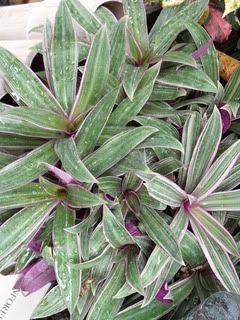Moses-in-the-Cradle

Tradescantia bermudensis is one of those plants with a lot of names. Tradescantia spathacea variegata (or “tricolor”) refers to the same plant. It goes by Moses-in-the-Cradle, Moses-in-the-Bulrushes, Moses-in-the-Basket, Moses-in-the-Boat, Boat lily, Oyster Plant and Rheo, among other things. With plants like this, it is easy to see why the Latin names of plants are so important. It’s hard to keep these things straight!
 T. bermudensis is called Moses-in-the-Cradle because of the small white flowers that form nestled in the leaves which resemble little boats. Other Tradescantias are also sometimes referred to as Moses-in-the-Cradle.
T. bermudensis is called Moses-in-the-Cradle because of the small white flowers that form nestled in the leaves which resemble little boats. Other Tradescantias are also sometimes referred to as Moses-in-the-Cradle.
Moses-in-the-Cradle prefers bright light; full sun to part shade will do, but the coloration of the leaves will be most distinct in full sun. A southern window is best if you are in the northern hemisphere or a northern window if you are in the southern hemisphere. A western exposure is next most desirable, but eastern will work in a pinch.
This plant is tolerant of drier conditions so it is forgiving of forgetful watering. Try to keep the potting mix evenly moist and water regularly. If the potting mix is dry an inch or so down it is safe to water.
It shouldn’t be necessary to fertilize your Moses-in-the-Cradle more than a few times a year. Fertilizing your plant once a month during the growing season will help produce a full and bushy plant with lots of little flowers. Another option would be to use a slow-release fertilizer applied at the recommended rate when the plant sends out its first flush of growth in the spring.
Propagation of Moses-in-the-Cradle is very simple. Offsets can be taken from the parent plant and placed in their own pots; they will root readily. Stem cuttings can also be taken.
Moses-in-the-Cradle isn’t prone to insect pests, but it never hurts to keep an eye out. Insects are most likely to hide down inside the leaves or under debris. Keep the plant clean by removing any dead leaves and periodically look the plant over; you shouldn’t have any problems with it.
While Tradescantia bermudensis is not specifically known to be toxic, its plainer relative, Tradescantia spathacea (a non-variegated form) is considered toxic. Keep this in mind if you have pets or children around. The sap is the part to be wary of. It can cause skin irritation and definitely shouldn’t be eaten. If you get the sap on your hands while handling the plant, be sure to wash them thoroughly before doing something else. You certainly don’t want to get it on your face or in your eyes.

Moses-in-the-Cradle prefers bright light; full sun to part shade will do, but the coloration of the leaves will be most distinct in full sun. A southern window is best if you are in the northern hemisphere or a northern window if you are in the southern hemisphere. A western exposure is next most desirable, but eastern will work in a pinch.
This plant is tolerant of drier conditions so it is forgiving of forgetful watering. Try to keep the potting mix evenly moist and water regularly. If the potting mix is dry an inch or so down it is safe to water.
It shouldn’t be necessary to fertilize your Moses-in-the-Cradle more than a few times a year. Fertilizing your plant once a month during the growing season will help produce a full and bushy plant with lots of little flowers. Another option would be to use a slow-release fertilizer applied at the recommended rate when the plant sends out its first flush of growth in the spring.
Propagation of Moses-in-the-Cradle is very simple. Offsets can be taken from the parent plant and placed in their own pots; they will root readily. Stem cuttings can also be taken.
Moses-in-the-Cradle isn’t prone to insect pests, but it never hurts to keep an eye out. Insects are most likely to hide down inside the leaves or under debris. Keep the plant clean by removing any dead leaves and periodically look the plant over; you shouldn’t have any problems with it.
While Tradescantia bermudensis is not specifically known to be toxic, its plainer relative, Tradescantia spathacea (a non-variegated form) is considered toxic. Keep this in mind if you have pets or children around. The sap is the part to be wary of. It can cause skin irritation and definitely shouldn’t be eaten. If you get the sap on your hands while handling the plant, be sure to wash them thoroughly before doing something else. You certainly don’t want to get it on your face or in your eyes.
This site needs an editor - click to learn more!
You Should Also Read:
Purple Heart
Wandering Jew
Houseplants Newsletter
Related Articles
Editor's Picks Articles
Top Ten Articles
Previous Features
Site Map
Content copyright © 2023 by Lisa Beth Voldeck. All rights reserved.
This content was written by Lisa Beth Voldeck. If you wish to use this content in any manner, you need written permission. Contact
BellaOnline Administration
for details.


